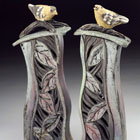NANCY BRIGGS
artwork | audio | statement | 2008 update | galleries
artwork
see more work: Phalanx (1990); Herstory (1997)
audio 
- Mom & art (40 sec. | 277KB): listen | read
- High school (31 sec. | 215KB): listen | read
- College & clay (22 sec. | 150KB): listen | read
- Artwork (54 sec. | 369KB): listen | read
- Flying dreams (60 sec. | 409KB): listen | read
- Advice (47 sec. | 324KB): listen | read
artist statement
Nancy Briggs has been on the faculty of the Des Moines Art Center since 1986 and currently teaches ceramics to children and adults. Her work has been exhibited in regional and national juried exhibitions including Iowa Artists Annual (1998, 1995, 1990), Iowa Exhibited, Art and Ethics (Sawtooth Center for the Arts, Winston-Salem, NC), and Women's Voices (Drake University).
Nancy uses the Raku firing technique to give her pottery and sculpture a mysterious, ancient quality. Her pottery is quickly heated to melt the glazes, and is then removed from the kiln when red hot and placed in beds of sawdust to smoke the wares. This gives the clay its black color, and the glazes their rich metallic look. Raku pottery is fragile and porous, so its main function is decorative.
2008 update
I am happy to say I reached my goal of being a full time artist/potter. I teach about five ceramics classes a week at the Des Moines Art Center, and the rest of my time is spent producing work for sales at art fairs and galleries. The demands of the marketplace do have some limits on creativity/spontaneity. Jurying into events 6-8 months in advance means I must produce a consistent body of work that matches the jury images. It's amazing how much attention goes into maintaining a 10'x10' display. I need to make artwork that has a strong subject matter that also has appeal to the general public. I do not feel this has lowered the quality of my work, but it does not leave time or room for experimental, bulky or hard to sell art.
The theme of my current work is nature, especially tree leaves (gingko and oak especially). Being originally from Wisconsin and still living in the Midwest, this imagery comes naturally to me. I especially love to wind and intertwine leaves with bark textures on the surface of my work. As humans, our well-being is connected to plants, and I love the resiliency of trees throughout the seasons. I have been happily using this imagery for the past 10 years, and the work continues to mature and grow. I concentrate on improving the drawing and carving quality of my images, and on achieving more movement and flow in the pots. I am currently exploring using wood elements with the clay, mainly using twisting roots as "pedestals" for the pots.
The teaching never gets boring, it gets more interesting every year. In teaching, I can be creative and experiment in ways I can't in my market work. The interaction with my students is very important to me. They are my community and my friends of many ages from 6 years old to 75.
I have also been learning to work in pastel. Again, organic forms such as leaves and fruit occupy my pages. I portray the subject very close up so the emphasis is on form and division of space. I gravitate to similar colors that I use on my pots. People say they can see my fascination with form in the pastels too. I think itís important to continue to develop in a medium that is less strenuous physically. Pottery making is pretty hard on the body, and as I get older I want to have alternatives in place. Developing my drawing and color skills has made me more self confident and more complete as an artist.
I will always be an object maker, pastel painting, or pots or something. Itís what makes me feel alive and is as natural to me as breathing. Itís hard work and dirty, too, but I always say that nothing good happens without some kind of dirt. Gardening, pottery making and working with pastels are all just messy enough to keep me happy. I am grateful to the universe for being able to live the life I do.
audio text
Mom & art
My mom had been for several years doing volunteer work, which was her way to have some kind of career. She would go to the mental health hospital and work with the patients there doing clay projects. She'd come home and she'd be so excited about it. And her insight into people based on what they made and the relationships that came out of her volunteer work with these people in clay—I was just fascinated. So, I think one of the reasons that teaching is important to me now, is because of communication and the insight and sort of the healing properties of working with art. And that came from my mother.
High school
I didn't take an art class until second semester my junior year. And I stumbled into taking an art course, I don't know why. I usually took music, so there wasn't a lot of time. I mean, the drawing and stuff, that was okay, I was pretty awkward with it. But something about that clay, I really liked it.
For me, probably just the self-discipline and sheer dogged stick-to-it-iveness got me to be an artist, more than all these early inklings of talent. Because that didn't show. It was just I decided that that's what I wanted, and I was going to channel it.
College & clay
I got into college the first year they only allowed you to take the design courses. You couldn't take any studio. So I was just dying. I used to stand at the doorway of the clay studio. You know, I was just dying to get in there. And as soon as I got in there, first semester of my sophomore year—bing. I was in clay and I stayed in that room for the rest of the years that I went to college. And I've never been out of a studio since. It just took me.
Artwork
I have two facets to the things that I make. And those are the pots, decorative objects for people to enjoy in their homes. And the other is my artwork, which is a lot more personal. It's harder for me to do. It's a lot more mental work for me to do.
That personal search for the inside of myself is important to me, and I'm driven to put it in my art work, and it also gets almost embarrassing sometimes because you have to talk about your work to others. But I find when you expose these emotions to the public, they reach such accord with other people, that you almost bond with them more. I mean, I have had people come up to me after viewing my work, crying, and touching me, and talking to me about the fact that I was open about these things and how they had shared a similar feeling or a similar circumstance.
Flying dreams
I have often had flying dreams. In these flying dreams, I would step out of my house and you just kind of step up and there you are and you're up there and you're looking at things from high up, and feeling the breezes and kind of this floating feeling. And then I would always have this moment of panic, and think, But how do I steer? What if I go too high? How do I get down? And bang, I'd just be there. And it was just such a bummer. Then finally one night I had a flying dream, and I went up and the winds took me. And it was particularly buoyant and particularly delightful. I went way, way up there. I was able to soar higher and farther because I just quit trying to steer and control and manage every little thing.
I mean, it's good to have drive and focus and things like that, but sometimes you have to realize that the winds are going to help move you along, and help you on your path. And to just quit fighting it all the time, and just move with it. For me, I guess, in doing my clay work, I finally did find a niche.
Advice
I don't mean to ever discourage a budding young artist, but they do need to realize that there are facts of living that they are going to have to cope with. You really need a good partner to do this. Very, very hard to do it alone. You need to get your portfolio together. You need to present yourself. You need to be able to say something about your work. You have to deal with the facts of living just like any other business. And that's hard.
And I also kind of resent how business-like making art has become. You don't want to lose the dream or the emotion or the reason why you started it. You have a lot to contribute to the society simply for the self-discovery and the emotional aspects of making art, that are real important than just making things to sell, or getting your work in a gallery.





